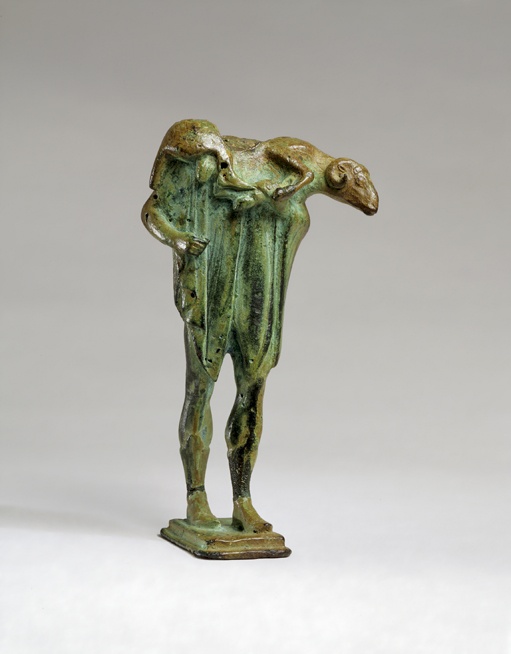
Bronze
H: 11.2 cm
Provenance: no indication
Greek, North-East Peloponnese?
First quarter of the 5th century B.C.
Ex collection:
Giorgio Sangiorgi, Rome
Solid-cast by the lost wax process, the casting flawed [1], but otherwise delicately worked over in the cold and burnished.
Condition: dark olive green to a light green, in parts overlaid with brown earth deposit that has become smooth; the odd spot of blue, parts of the surface scraped, a nick to the left side of stepped base and holes here and there over the surface from
air bubbles.
The figure slightly leaning to the left, bent at the ankles, the neck and head of the figure with a section of the ram's back missing.
A possible representation of the god Hermes, messenger and guide, and respectful emissary of Zeus. Hermes was also shepherd and god of Arcadia with its bountiful flocks of sheep. Here he is dressed in a cloak which falls in two wide folds ending above his knees and which at the back clings to his body, curving in above and moulding the buttocks, and ending across the middle of the thighs. A wide pleat at the back, a turning over of the edge, falls in front in swallow-tail folds and frees his right arm and hand which probably held a shepherd's crook, though a kerykeion is possible. Shod in high boots with a tongue above the middle of the shin, he stands on a two-tiered base very similar to the one under the New York Apollo [2].
He carries the ram draped over his shoulders holding it with his left hand by its left front leg and its right hind leg, but also possibly by the other hind leg tucked in behind. The animal is portrayed with extreme sensitivity depicting its discomfort, the bend of its neck with its slightly bulging underside expressing its apprehension. Its fleece indicated by incised criss-crossing lines forming unusual rhomboids without a satisfying parallel; though there is a statuette of Athena in Hanover [3] of unknown provenance whose aegis is decorated in a very similar fashion. She is ascribed by R. Tölle-Kastenbein to a provincial master whom she says is neither definitely Arcadian nor Laconian. The statuette is indeed provincial, but we are surely in the Peloponnese.
Though there is a whole group of terracotta Kriophoroi from Medma, they only bear comparison for the subject except for one [4] which is dated to the beginning of the 5th century, where the shepherd's cloak - though very plain - clings to the front of the body somewhat in the same spirit as it does here on the back of the statuette. The terracotta statuette would also seem to have sharp shins. A heavy-set bronze Kriophoros [5] from the sanctuary of Apollo at Metapontum is only thematically related. The author recalls a terracotta statuette whose body and legs are almost identical to this ram-bearer, in the museum in Palermo, which must come from the Malophoros deposit at Selinunte. The ram's head bears comparison with certain Attic rhyta [6] in the round and though on these latter the muzzle is very similar in profile, they are not as narrow towards the nostrils.
The epithet Kriophoros for the god harks back to an historic event when Hermes managed to avert a plague from the town of Tanagra by carrying a ram round the city walls [7]. Kalamis, a Boeotian sculptor much influenced by Sicyon, made a famous statue [8]. It may be that the present statuette and a bronze once belonging to Sabouroff [9] are precursors of the cult statue of Tanagra.
The Hermes Kriophoros in Boston [10] described as perhaps Sicyonian [11] is possibly a predecessor for the subject. Our statuette straddles the borderline between the end of archaic and the early Severe Style and in all likelihood is to be placed in the North-East of the Peloponnese, probably a work to be ascribed to Sicyon where the new style was born, though neither Corinth, Arcadia, or Sicily should be totally excluded.
On view: Antikenmuseum, Basel: 1968-1973
Exhibited and Published:
Meisterwerke griechischer Kunst, cat. no. V 254, pp. 222-223 ill. (Nicholls, R.V.: JHS 82, 1962, p. 204.)
Hommes et Dieux, cat. no. 146, pp. 230-231 ill.
Published:
G. Siebert, G.: LIMC, V, 1, no. 274, p. 312.
Mentioned:
Dörig, J.: Kalamis-Studien, JdI 80, 1965, p. 223 n. 366. - Ortiz, G.: Connoisseurship and Antiquity. Small Bronze Sculpture from the Ancient World (Malibu, 1990), pp. 274-275 fig. 27.
1 With air bubbles owing to a bad mixture of the molten metal and/or more probably to a too rapid cooling responsible for the break on the animal's back.
2 Metropolitan Museum of Art 07.286.91: Richter, G.M.A.: The Metropolitan Museum of Art. Greek, Roman and Etruscan Bronzes (New York, 1915), no. 60, pp. 41-42, said to be from near Andritsena, Arcadia (see mention cat. no. 142).
3 Kestner-Museum 1961.17: Tölle-Kastenbein, R.: Frühklassische Peplosfiguren (Mainz, 1980), no. 42d, p. 237, pl. 166a.
4 Reggio, Museo Nazionale: Langlotz, E., Hirmer, M.: Die Kunst der Westgriechen (Munich, 1963), no. 56, p. 70.
5 Metapontum Antiquarium 31142: Rolley, Cl.: Trois bronzes de Métaponte, RA 1989, pp. 115-117.
6 Hoffmann, H.: The Persian origin of Attic rhyta, AntK 4, 1, 1961, p. 21 ff.
7 Pausanias IX, 22, 2.
8 Dörig, J.: JdI 80, 1965, p. 220 ff.
9 Dörig, J.: op. cit., p. 222 ill. 66 (recorded in Furtwängler, A.: Slg. Sabouroff II, pl. 146, now lost).
10 Museum of Fine Arts H.L. Pierce Fund 99.489: Comstock, M., Vermeule, C.: Greek, Etruscan & Roman Bronzes in the Museum of Fine Arts Boston (Boston, 1971), no. 23, pp. 25-26.
11The Gods Delight. The Human Figure in Classical Bronze (Cleveland, 1988), no. 9, pp. 81-86 (M. True).